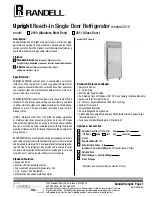
5-11
TROUBLESHOOTING THE MOTOR
NOTE: Refer to the “Motor Failure Modes
Chart” at the bottom of the page.
1.
Motor does not hum or rotate.
a) 1, 2, 3, 5, 6.
b) Make sure refrigerator is plugged in.
c) Make sure freezer door is completely
closed.
d) Make sure selection button is in UN-
LOCK position.
e) Wait 1 minute after an ice jam occurs
for motor’s surge protector to automati-
cally reset.
f) Disconnect/reconnect the 6-pin harness
to the motor 3 - 5 times to remove any
oxidation buildup on the connector pins.
g) Check power in the circuit (see “Check-
ing The Switch Pack on page 5-14 ).
2.
Motor hums but does not rotate.
a) Clear ice jam in ice bin.
b) Possible broken gear inside motor as-
sembly.
3.
Motor starts but heats rapidly.
a) 2, 3, 5.
4.
Motor runs too hot after extended opera-
tion.
a) 3, 4, 6, 9.
5.
Reduction in power—motor overheats.
a) 2, 5, 6.
6.
High no-load speed (30 RPM is nominal).
a) 2
7.
Excessive noise (mechanical).
a) 2, 7, 8.
8.
Jerky operation—severe vibration.
a) 2.
1.
Open circuit in connection to line (e. g. house fuse is blown
or motor is defective).
2.
Defective motor.
3.
Overloaded motor (mechanical failure in load).
4.
Ventilation blocked.
5.
Wrong connection to motor.
6.
Improper or low line voltage.
7.
Poor alignment between motor and load (e. g. loose motor
mounting).
8.
Amplified motor noise due to mounting conditions.
9.
High ambient temperature.
Motor Failure Modes Chart
Electrical Shock Hazard
Disconnect power before servicing.
Replace all panels before operating.
Failure to do so can result in death or
electrical shock.
WARNING
Summary of Contents for 4322658A
Page 4: ... iv NOTES ...
Page 12: ...2 6 NOTES ...
Page 14: ...3 2 NOTES ...
Page 24: ...4 10 NOTES ...
Page 44: ...6 4 NOTES ...
Page 48: ...CORPORATION ...














































